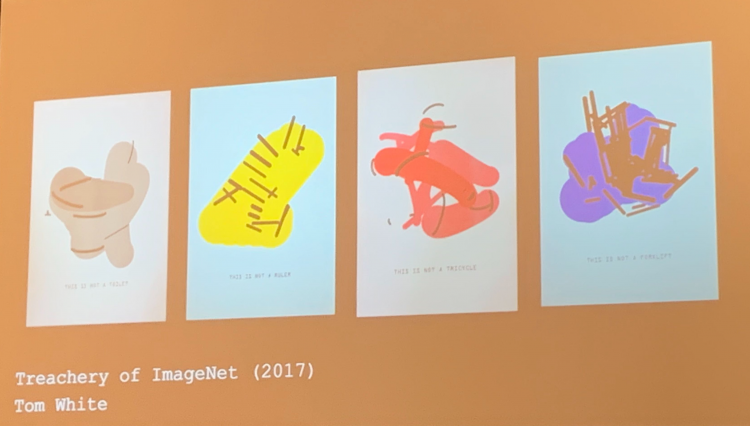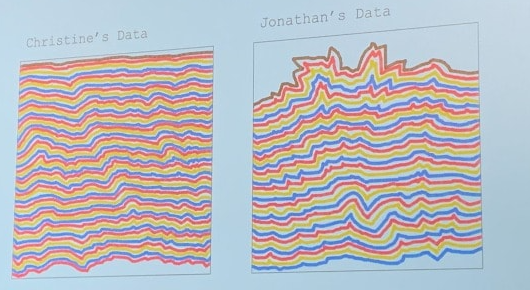The Idea Becomes the Machine That Makes the Art
Christine Stavridis
Jonathan King
Overview
Sol LeWitt was a prolific American artist credited with founding Conceptual Art and Minimalism. This talk is inspired by his series of participatory, conceptual art chosen, "Wall Drawings". The Wall Drawings are large-scale installations that grow from a set of simple written instructions by Sol LeWitt himself.
Preface
The speakers are Jonathon King, a software & systems automation for a lab automation company, and Christine Stavridis, a product designer, front end terminate engineer, educator. They share a passion for conceptual art, and this projection is about exposing hidden layers in art preservation. It started with a call for presentations at StrangeLoop, which gave them the kickstart they needed to outset on a project together exterior of work, engaging with Machine Learning, Art, & Philosophy. When looking for topics, Sol LeWitt is the start person who came to mind.
Sol LeWitt
Sol LeWitt was an artists who lived from 1928 - 2007. He was a founder of the minimalist and conceptual art movements. He was known in particular for his Wall Drawings, whose titles are actually the instructions for generating the drawing. LeWitt didn't usually execute the drawing himself; instead they were done by a large squad of assistants.
Wall Drawings And The Idea That Creates The Machine
Christine and Jonathon feel like these wall drawings are a perfect case of a wholly encapsulated system. They contain all the instructions needed to install themselves, and you lot can recall of their titles every bit psuedocode for art. These simple instructions can create a beautiful array of generative works, where the interactions betwixt the drafters and the physical wall it's installed on have meaningful affects on the piece. LeWitt had the idea that lines could exist drawn by anyone anywhere, within the bounds of the instruction, and the idea was still true.
However, even though LeWitt felt like anyone could install these and they were authentic, just in guild to sell them they needed a document. Certificates cannot exist issued without either his consent or the consent of his manor.
Making The Motorcar That Makes The Art
So Christine and Jonathon decided to attempt their paw at implementing Wall Drawing 797 using machine learning. Their beginning prototype used React, p5.js, and node.js. They intended to use Mechanical Turk to go a lot of human input for the model which would all exist drawn on to make 1 wall drawing. Withal, the first one didn't piece of work very well or aesthetically like to LeWitt's Wall Drawings.
Then for the next iteration, Jonathon and Christine used just their work equally inputs, and information technology looked much better, though information technology took about 30 minutes to make each input cartoon and they had to take lots of mental and concrete breaks. Given that it was so intensive to produce each input for the model, they didn't feel like their initial multi-contributor vision was practical while still paying a decent wage, which was of import to them. And, as it happened, it was in-keeping with LeWitt's philosophy!
"I had the idea that if you tin pass on the instructions from one person to another that they can draw a line … [this idea] is nonetheless true. But although anyone can do the kinds of lines that are very precise, only a few people tin do them very well". - Sol LeWitt
One other approach they tried was preparation a cyberspace on the instruction themselves for 250 of LeWitt'south wall drawings. A few were pretty successful if you didn't expect as well shut (new wall drawings number) Why did these instructions come out wonky? Information technology turns out LeWitt didn't have a lot of variance in his titles, so it was hard to avoid over-training the models and completely replicating existing titles. Besides, in a subsequently period he got more than simplistic (for instance naming ane 'Splat') and there wasn't enough to learn from them. They considered if Markov Chains would work ameliorate here, only simply it ultimately felt besides far from LeWitt's thoughtful way.
Then they realized: they were just doing ML for ML'south sake.
But is it Art?
"New materials are ane of the slap-up afflictions of contemporary art. Some artists misfile new materials with new ideas". -Sol LeWitt
What are the premises of the power of machine learning? Where is it useful, and where is it weak? What other artists are using it in a meaningful way?
They went through some examples of artists using automobile learning for art well. They included:
Sougwen Chung, who trained a neural net that she and then paints with collaboratively.
Tom White, who was trying to create GANs that could fool ImageNet.

Holly Herndon, who is working on training an AI baby on her and her partner'south own voices. It's learning to sing and was recently credited on her new album.
Memo Akten, who says 'nosotros come across things not as they are but as we are' and has fabricated an artificial neural network that looks out on the globe and tries to make sense of what it sees based on what it's seen earlier.
Then then they asked themselves, are we still doing this in honor of Sol? Or is it for ourselves? What would he want from information technology?
He always wanted his work to await contemporary, which is why he chose the colors and shapes he did, and he tested them time and again before making his instructions. This besides means things need to be re-painted periodically, because they exist in physical space and become worn and damaged over time, while he wanted them to always be fresh. So in that location are many participants in his fine art and many assistants. They were with him from the commencement, and Jonathon and Christine learned that it's common in the art globe for assistants to be improve at certain technical details even than the artists. So their knowledge is something special to replicate and preserve.
Artistic Preservation And Knowledge Transfer
"Art is made by human being beings not machines" - Sol LeWitt
Then Jonathon and Christine decided to attempt and bring humans dorsum into the procedure by trying to capture the technical knowledge of generations of LeWitt's draftspeople. They used p5/js and pix2pix to kickoff looking instead at the washes in LeWitt's wall drawings. Washes are the texture in the groundwork of painted lines in LeWitt'south wallpaintings. His draftspeople used very particular brands of inks, diluted down precisely and practical evenly to the wall to get the desired effect. Christine and Jonathon chose to model this pocket-sized simple problem to help knowledge transfer betwixt assistants.
In p5 you lot can quickly approximate this texture, simply how practice you capture the determination making process it took to get there? They looked at swatches of the wash and identified areas they felt needed more work to look correct, then used that information to railroad train a neural cyberspace to critique the quality of the launder. This seemed like a practiced fit for machine learning in particular because an assistant could retrain the model as their taste matured to improve it'south ability to tell if a wash is good or not.
With Christine and Jonathon's original Mechanical Turker model, they had imagined a monolithic model with tons of inputs from different mturkers creating a mega-model. But once they started thinking about individualized models like the one that had opinions about good washes, they felt like they had a improve approach.
Many of LeWitt's assistants have special and unique knowledge, which fits in better with a 'many models' arroyo, where each model reflects its own cognition and specialty. They took what they'd learned and created 2 networks trained on inputs that each of them generated separately. It only took 6 drawings from each of them to train the models, which was a lot less than they expected.

By doing this, they were able to make models that captured their unique styles and sense of taste, and produced work that resembled human being assistants collaborating. Not all the assistant-models worked well together however - simply even that discordance reflects almost an artistic argument.
Conclusion
So where do nosotros become from here? Christine and Jonathan want to combine model and human outputs in the physical world, and to talk more to the assistants to detect out how machine learning algorithms can help preserve LeWitt'due south work. They're too left with the question of how they validate that the models actually captured their artful and intentions. And if that's even necessary! Every bit they put information technology,
"We wanted these models to capture advice from the past, but the thing nearly advice is y'all don't have to take it".
Source: https://about.sourcegraph.com/strange-loop/strange-loop-2019-the-idea-becomes-a-machine-that-makes-the-art-that/
0 Response to "The Idea Becomes the Machine That Makes the Art"
Post a Comment